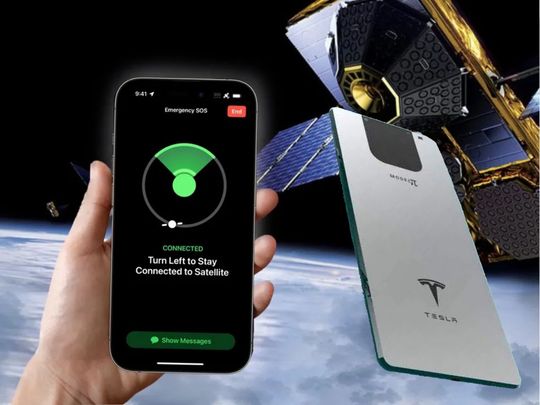
Apple has bolstered its space links, with a 20 per cent stake in Globalstar, and investing up to $1.5 billion to expand satellite phone service coverage.
With the unexpected move, the California tech giant has secured a way to boost iPhone connectivity worldwide.
CEO Tim Cook’s game-changing decision to ramp Apple’s stake in Globalstar has the potential to redefine global connectivity.
This strategic partnership could bring iPhones online from the world’s most isolated regions, expanding Apple’s reach and influence far beyond traditional cell networks.
Battle for global connectivity
It means satellite signals can be picked up and transmitted directly via phones, without the need for “middle-ware” or external ground antennas or transceivers on the customer side.
Apple's stake in the satellite operator, announced on November 2, gives the iPhone maker a direct line to mobile satellite service (MMS).
Apple has earmarked up to $1.75 billion to refresh and expand GlobalStar’s satellite network.
This could potentially allow Apple to compete (even if indirectly) with the likes of AST, SpaceMobile, Elon Musk's Starlink, and other satellite constellations like OneWeb and Kuiper in the battle for global connectivity.
Remote connectivity
Globalstar says the extra funding will deliver expanded MSS, which require a new satellite constellation, expanded ground infrastructure, and increased global MSS licensing.
Louisiana-based Globalstar has been a key player in satellite communicationsfor over 20 years.
• It provides two-way voice and data communication to mobile devices and vehicles in remote areas or when terrestrial networks are unavailable.
• MSS uses satellites to provide coverage over large areas.
• Gobalstar has been operating its MSS system in the US for more than 20 years.
• Globalstar has also received MSS and terrestrial service authorisations in several African countries, including South Africa, Mozambique, Gabon, Rwanda, and Botswana.
With the deal, Apple is paying for its own satellite constellation which will be utilised likely for SOS, text messaging and IoT over satellite spectrum to be used with Apple devices.
iPhone models with MSS
The initiative showcases Apple’s push toward greater connectivity options.
GlobalStar uses Canada-based MDA Space to design and build their satellites. In August, Globalstar cleared a US regulatory hurdle that will allow it to add new and improved satellite features to iPhone models.
All iPhone 14 or later models can already use a satellite connection when there’s no cellular and Wi-Fi coverage to text emergency services – for requesting roadside assistance, messaging friends and family, and sharing location.
Globalstar’s MSS technology uses satellites to keep people connected, whether they’re in the middle of the wilderness or far out at sea.
Emergency communications
By working with Globalstar, Apple can now offer emergency communication features through a reliable network of low-orbit satellites, which cover vast areas that regular cell towers simply can’t reach.
In August, Globalstar cleared a US regulatory hurdle that will allow it to add new and improved satellite features to iPhone models.
The move is seen as a strategic leap for Apple. For one, it means satellite signals can be picked up and transmitted directly via phones, without the need for “middle-ware” or external antennas or transceivers.
Tesla to respond with Pi phone?
Tesla/Space X CEO Elon Musk has made known the conditions under which he'd launch his own phone brand. His Starlink network already has about 7,000 small mass-produced satellites in space, as of September 2024.
In 2022, Musk declared in a tweet: “If there is no other choice, I will make an alternative phone”.
He was responding to a tweep who posed a hypothetical situation that Apple & Google would boot Twitter from their app stores.
To which Musk responded: “I certainly hope it does not come to that.”
Apple-Globalstar deal
Under the deal, Apple will support Globalstar’s satellite network financially, securing 85 per cent of its capacity to support Apple’s iPhone emergency call feature.
This means Apple devices could have the power to reach out from anywhere – creating a safety net for users lost, stranded, or in need of help where no cell signal is available.
• It has a constellation of 48 Low Earth Orbit (LEO) satellites (with four spares in orbit) and second-generation ground infrastructure deliver coverage and digital communication services to customers.
• Globalstar satellites operate independently and cover areas such as Europe, the Americas, Australia, North Africa, parts of Asia, and the Middle East.
• Apple has been using Globalstar's current network of 31 L-band satellites since 2022 to enable its latest iPhones to access emergency services when terrestrial networks are unavailable.
• Globalstar's satellites provide communication solutions for areas without cellular coverage. Users can check in via talk, text, or email, or trigger "Search & Rescue" services in an emergency.
Technological edge?
With this deal, Apple gains a new edge in the tech world, bringing satellite communication directly into people’s pockets. For Globalstar, this partnership fuels expansion and cements a strong future in the rapidly growing satellite industry.
Starlink, for its part, plans to launch thousands of satellites to space in a mega-constellation, which are then refreshed or upgraded every five years with newer technology. Old satellites are decommissioned and return into Earth's atmosphere where they burn up.
• This service, being rolled out through collaborations with mobile carriers in multiple countries – T-Mobile (US), Rogers (Canada), KDDI (Japan), Optus (Australia), One NZ (New Zealand), and Salt (Switzerland) – allows users in remote or underserved areas to access cellular coverage via satellites. More partnerships are being formed.
• To support this initiative, SpaceX has filed to add specialised payloads to 2,016 of its Gen2 Starlink satellites.











